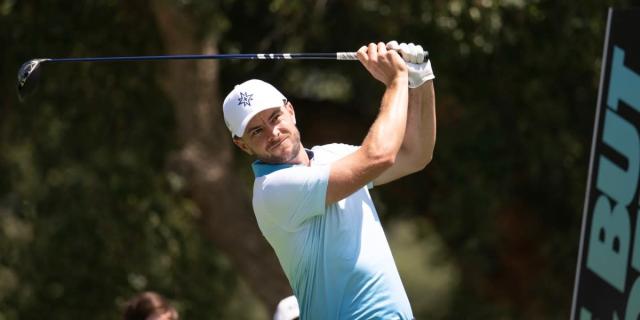
Feature: Challenge vs Web.com Tour
The 2013 PGA Tour season may only be in its nascent stages, but one thing is already abundantly clear: the rookies coming through have no intention of arriving quietly. In the first full-field event of the season, the Sony Open in Hawaii, Russell Henley broke a tournament scoring record to win on his PGA Tour debut. The following week at the Humana Challenge, David Lingmerth lost out in a play-off in his second career start, and other rookies, like James Hahn and Brian Stuard, have recorded top-five finishes.
Common ground
What do all these names have in common? They came through the Web.com Tour. Granted, Q-School graduates, such as Scott Langley, are also making an impression, but as each season passes, the second-tier is becoming stronger and stronger. As such, young golfers are coming through with supreme talent, self-belief and all the tools required to succeed at the top level. The Web.com Tour is the perfect breeding ground, and the number its graduates that have triumphed on the main circuit in recent times is testament to that.
That being said, the European’s equivalent Challenge Tour is also producing a number of golfers who are making an impact at the top level. Players like Thorbjorn Olesen and Rafa Cabrera-Bello have all progressed through the Challenge Tour in recent years, and a number of others have gone on to record European Tour victories. For the purpose of comparison, let’s take a look at the number of second-tier graduates who have gone on to win on their respective top-tier tour (since 2008).
| Web.com Tour grads with PGA Tour wins | Challenge Tour grads with European Tour wins |
| Marc Leishman (2008) | David Horsey (graduated in 2008) |
| Arjun Atwal (2008) | Tano Goya (2008) |
| Bryce Molder (2008) | Richie Ramsay (2008) |
| Scott Piercy (2008) | Rafa Cabrera-Bello (2008) |
| Derek Lamely (2009) | Garther Maybin (2008) |
| Chris Kirk (2010) | Christian Nilsson (2008) |
| Brendan Steele (2010) | Edoardo Molinari (2009) |
| Jhonattan Vegas (2010) | Nicolas Colsaerts (2009) |
| Keegan Bradley (2010) | Rhys Davies (2009) |
| Ted Potter Jr (2011) | Julien Quesne (2009) |
| Jonas Blixt (2011) | John Parry (2009) |
| Russell Henley (2012) | James Morrison (2009) |
|
| Thorbjorn Olesen (2010) |
|
| Berndt Wiesberger (2010) |
|
| Lee Slattery (2010) |
|
| Scott Jamieson (2010) |
|
| Matthew Zions (2010) |
|
| Ricardo Santos (2011) |
I have to admit to being a little surprised about the above statistics, but, in my view, the Web.com Tour (formerly the Challenge Tour) has begun to establish itself as the premier second-tier tour since the turn of the decade. I also believe that as we move forward, the overall gulf between these two tours will begin to grow and grow, and that some world-class golfers will progress through the American second-tier tour.
Times are changing
Granted, a number of Challenge Tour graduates since 2008 have performed admirably on the European Tour, but it seems a new pattern has started to emerge: more Americans graduates have won from 2010 to today than their Challenge Tour peers. This figure also needs to be contextualised. Over the past couple of seasons - thanks, in part, to the rising popularity of the FedEx Cup - the PGA Tour has become stronger and stronger and the European Tour, on average, has become weaker. Few would argue it is easier to win in America, and yet, in recent times, an inverse proportion between rookie success on the European and PGA Tour has become evident. What’s more, Zions and Santos won in co-sanctioned events. It is also interesting to compare the demographics of the recent winners – all the seven PGA Tour victors since 2010 are below 30 years of age, as opposed to three on the European Tour.
Power shift
There has been a fundamental power shift between the two second-tier tours of late, and I don’t see this trend changing. American officials have worked hard in recent times to spruce up the Web.com Tour, and there can be no doubt it’s seen as more attractive than its European counterpart. There is more money on offer week in, week out on the Web.com Tour, and recent changes will serve to make it even stronger. The Web.com Tour finals could potentially see 50 Web.com Tour players promoted to the main tour, and being in direct competition with PGA Tour players will offer all the motivation they need. In addition, Q-School is now the only way to earn a Web.com Tour card, meaning only the best, and those adept at dealing with pressure, will come to the fore.
The Web.com Tour has been a brilliant breeding ground for some of the world’s best players, and structural changes will only serve to increase its influence. Bubba Watson, Brandt Snedeker, Keegan Bradley and Webb Simpson, all Web.com Tour graduates, currently sit inside the world’s top 15, and there is no doubt in my mind they’ll be joined by others in the near future.
College pedigree
What is also interesting to note is that all four of these players played the game competitively at collegiate level. Not only is college the perfect starting point for prospective top-tier professional golfers, but the Web.com Tour often offers sponsors’ exemptions to college players – something that simply isn’t possible in Europe. In some cases, the best college golfers are handed invitations to PGA Tour events. In 2011, Bud Cauley managed to earn a 2012 card on the back of his performances in these tournaments. The lack of a European collegiate system also drives the best young European talent to America, increasing the university talent pool and, by extension, the standard on the Web.com Tour.
The statistics may not immediately suggest there is a discrepancy between the two second-tier tours, but few could dispute the Web.com Tour is stronger than its European counterpart. A gulf has started to appear over the past few years, and unless steps are taken, this will continue to grow. That isn’t to say that no quality players are coming through the Challenge Tour, but the world rankings, coupled with recent results, show that America is on top. There will always be great young European players, but the talent pool on the Web.com tour is deeper, and I can’t see that changing. The relative strength of the two top-tier circuits does appear to be proportional to its feeder tour.

Be part of the action with a selection of unique golf tournament experiences, from playing in a pro-am with the stars to watching the action at golf’s most illustrious events. Whether it’s the Masters or The Open, The Ryder Cup or WM Phoenix Open, build your own bespoke package with the experts at Golfbreaks.com.









